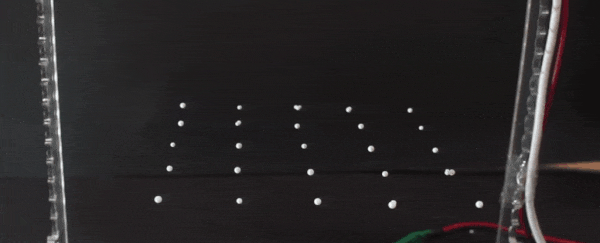Acoustic levitation - using the pressure generated by sound waves to levitate a single tiny particle - has been around a long time. Manipulating the particle and moving it through space is only a relatively recent development.
But now a pair of researchers from Spain and the UK have achieved a huge breakthrough: an acoustic levitation device that can move not one, but multiple particles, and all in different directions.
The work was conducted by mechanical engineers Asier Marzo of the Public University of Navarre in Pamplona, and Bruce Drinkwater of the University of Bristol in the UK.
(If those names sound familiar, you may be recalling their work to develop the world's first acoustic tractor beam, back in 2015. Good memory!)
This new device - what the team is calling "holographic acoustic tweezers" - is a new feather in their cap, and could be incredibly useful to industries such as pharmaceuticals, where acoustic levitation is used for containerless processing.
The principle is based on holographic optical tweezers (HOT), which use split and focused lasers, rather than sound waves, to create mid-air configurations of trapped particles in three dimensions (that's the holographic part).
However, lasers aren't suitable for all materials or applications, since they need a transparent medium for the photons to penetrate, and they are only capable of manipulating micrometre-sized particles.
Holographic acoustic tweezers (HAT) could fill those usage gaps, such as in vivo biomedical applications, or particles much larger in size.
The HAT consists of two arrays of 256 speakers, each about 1 centimetre (0.4 inches) in diameter, facing each other across an interval of about 23 centimetres. They operate at a frequency of 40 kilohertz, well above the range of human hearing, which is between 64 hertz and 23 kilohertz (although it would probably make dogs and cats uncomfortable).
At high volume, this produces a strong acoustic pressure, capable of levitating up to 25 individual particles, in a complex lattice of sound waves that can move and trap particles, based on the strength of the waves from the speakers.
The team demonstrated their technology in both two and three dimensions, and the three-dimensional tweezers are simply jaw-dropping.
Using styrofoam balls between 1 and 3 millimetres in diameter, the researchers execute a series of stunning mid-air manoeuvres such as forming a 3D icosahedron, assembling two strings, held at each end by styrofoam balls, and even pulling a thread through a hole in a piece of fabric.
"The applications of these acoustic tweezers are varied, but I especially like two. At millimetre scales, the displays or structures with a multitude of levitating particles to form different three-dimensional objects, although now, for the time being, we have begun for a cube. An example could be future 3D screens with voxels, cubic units of a three-dimensional object equivalent to the current pixels in 2D objects," Marzo told Spanish science news publication Agencia Sinc.
"And at micrometric scales, the manipulation of 3D cells to create structures beyond a simple culture in a two-dimensional Petri dish."
As we know from medical ultrasound, sound waves can penetrate our bodies without causing harm, and they are much more energy efficient than lasers. This means that this technology could be safely used inside the body to move things around.
There is more work to be done to get the technology to that point - but the team is already on the case, working to manipulate particles under water. They believe they will have achieved that goal in about a year.
Meanwhile, we will continue to marvel over the intricate dance of acoustically levitated particles in 3D space.
The research has been published in the journal PNAS.
